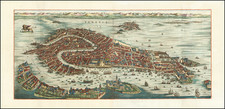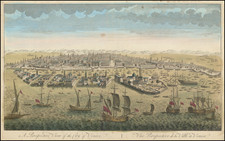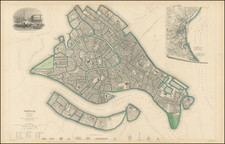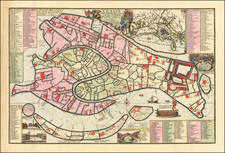The First Printing of the Earliest Known Plan of Medieval Venice
Fascinating medieval map of Venice, created by Tommaso Temanza's printed example of the oldest surviving plan of Venice, which he believed was first drawn in about 1140.
This map, which is found together with a 14th-century manuscript of the Chronologia Magna in the Marciana Library, was found and redrawn by Tommaso Temanza in 1781. The Chronologia Magna records events up to the year 1346. Temenzana recognized that the map was drawn in about the 1340s, since it includes the Ospedal Gualtieri, which was founded in 1330, but parts of the map were based on an earlier prototype going back to the twelfth century. He believed that the original was made around 1140.
The map is loosely in the form of a bird's eye view of the city, showing the layout of the streets, waterways, and buildings in great detail. It is drawn in a style known as "ichnography," which means that it is a plan view rather than a perspective view. This allows the viewer to see the city as if they were looking down on it from above, rather than seeing it from an angle.
One of the most striking features of the map is detailed accounting of early buildings (with names) in medieval Venice, which are depicted within the serpentine of the Grand Canal and the Rio della Sensa. The map also includes a single bridge, which seems to be the Ponte della Moneta, a wooden pontoon bridge designed in 1178 by Nicolò Barattieri. The structure was rebuilt in 1255 and 1264 and, following a number of collapses, was eventually replaced by the Rialto Bridge to provide better access to Rialto, the primary financial centre of Venice.
Tommaso Temanza (1705 –1789) was an Italian architect and author. One of his first jobs was as a proto or chief architecture for the Magistrate of the waterways. Among his works include the church of Santa Margherita (circa 1748) in Padua; the private chapel on the grounds of Villa Contarini located in Piazzola sul Brenta; and a loggia for Ca' Zenobio in Venice. His masterpieces are however for churches in Venice, including the cylindrical church of Santa Maria Maddalena (where his remains rest), the church of San Servolo and the chapel Sagredo in San Francesco della Vigna. The abandoned project for the facade of Ca' Sagredo in Venice. He is best known for his 1778 biography of architects from Venice: Vite dei più celebri architetti e scrittori veneziani.
The map was published in his Antica pianta dell'inclita citta di Venezia delineata circa la meta del 12. secolo, ed ora per la prima volta pubblicata, ed illustrata. Dissertazione topografico-storico-critica di Tommaso Temanza architetto, ed ingegnere della serenissima repubblica di Venezia Socio onorario delle due Reali Accademie di Parigi, e di Tolosa in Francia; ed in Italia della Clementina di Bologna, e della Olimpica di Vicenza, published in Venice in 1781.
Rarity
While Temanza's map is frequently reproduced by Venetian scholars in modern essays, it is quite scarce on the market.
This is the first example of the map we have seen.









![[Venice] Venetia](https://storage.googleapis.com/raremaps/img/small/42498.jpg)




![[ Venice - View of the Rialto District ] A View of the Realto Buildings at Venice | Vue des Edifices, du Realte de Venise](https://storage.googleapis.com/raremaps/img/small/97844.jpg)